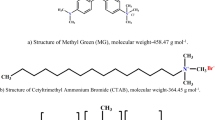Summary
Results of spectrophotometric, conductometric and dialysis studies on the interaction of acridine orange monohydrochloride dye with sodiumdodecylsulfate (anionic), cetyltrimethylammoniumbromide (cationic) and Triton X 100 (nonionic) surfactants have been reported. The anionic surfactant, SDS has been observed to undergo both electrostatic and hydrophobic interactions with the dye cation. Aggregation of the dye molecules can be destroyed when the surfactant is in large excess, whereas, excess dye can check micellization of SD S. At a ratio of AO:SDS=1:7 and above, dye embedded mixed micelles are formed. These remain in a separate phase, probably as coacervates. At lower ratios than 1:7, aggregation of dye molecules is induced, which being complexed with SDS become stabilized as colloids. The colloid and the coacervate have been observed to be thermally stable, negatively charged materials that can be broken by salts, and cations of higher valency are more effective in this regard. An 1:3 = AO:SDS colloid has beeen found to be sufficiently large like the coacervates to pass through a membrane having cut off permeability for molecular weights 12,000 and above. All the above features of AO-SDS interaction have been observed to be absent for AO-CTAB and AO-TX 100 systems, Even hydrophobic interaction has played an insignificant role in these cases. Thus, the dye cation, the cationic and the nonionic surfactants have almost retained their self physicochemical identities in solution in the presence of each other. Electrostatic interaction is thus the primary requirement for acridine orange-surfactant (anionic) system; the hydrophobic effect is secondary and may become co-operative.
Similar content being viewed by others
References
West, S. S., in: Physical Techniques in Biological Research,A. W. Pollister, Ed., Academic Press, New York, Vol.IIIC, (1970).
Hofmann, A. F., Biochem. J.89, 57 (1963).
Barry, B. W., G. F. J. Russell, J. Pharm. Sci.61, 552 (1972).
Singhal, G. S., E. Rabinowitch, J. Hevesi, V. Srinivasan, Photochem. Photobiol.11, 531 (1970).
Hevesi, J., E. Balint, B. Nemet, Acta Physica Chem. Szeged.29, 205 (1973).
Kawamato, M., W. Graumann, Acta Histochem.33, 238 (1969).
Watanabe, F., J. Phys. Chem.80, 339 (1976); Bull. Chem. Soc. Japan49, 1465 (1976).
Vitaghano, V., L. Costantino, R. Sartorio, J. Phys. Chem.80, 959 (1976).
Salter, M., W. B. Rippon, E. W. Abrabamson, Biopolymers15, 1213 (1976).
Rosenkranz, P., H. Schmidt, Z. Naturforsch.31 C, 679 (1976).
Mukherjee, P., K. J. Mysels, Critical micelle concentrations of aqueous surfactant system, NSRDS-NBS 36, Washington D.C., U.S.A., 1971.
Robinson, B. H., N. C. White, C. Mateo, Adv. Mol. Relaxation Processes7(a), 321 (1975).
Tondre, C., J. Lang, R. Zana, J. Coll. Inter. Sci.52, 372 (l975).
Moulik, S. P., S. Ghosh, A. R. Das, Ind. J. Chem.14 A, 302 (l976).
Moulik, S. P., S. Ghosh, A. R. Das, Ind. J. Chem.14 A, 306 (l976).
Moulik, S. P., S. Ghosh, A. R. Das, Ind. J. Chem.15 A, 345 (l977).
Moulik, S. P., S. Ray, A. R. Das, J. Phys. Chem.81, 1766 (l977).
Moulik, S. P., S. Ray, A. R. Das, J. Phys. Chem.80, 161 (l976).
Moulik, S. P., D. P. Khan, Ind. J. Chem.15 A, 267 (l977).
Reeves, R. L., R. S. Kaiser, H. W. Mark, J. Coll. Inter. Sci.45, 396 (l973).
“Colloid Science”, Ed. H. R. Kruyt, Vol.II, Elsevier (New York 1949).
Mukherjee, P., Advan. Colloid Interface Sci.1, 24l (l967).
Shinoda, K., T. Nakagawa, B. Tamamwhi, T. Isemura, “Colloidal surfactants”, Academic Press, New York, p. 20, 1963.
Moulik, S. P., D. P. Khan, Ind. J. Chem.16 A 16 (l978).
Mc Donald, J. C., J. S. Serphillips, J. J. Guerrera, J. Phys. Chem.77, 370 (1972).
Glasstone, S., Text book of physical chemistry, 2nd Edn., Macmillan, London, p. 1243, 1960.
Tanford, C., The hydrophobic effect: Formation of micelles and biological membranes, Wiley-Interscience (New York 1973).
Balint, E., E. Lehoczki, J. Hevesi, Acta Phys. Chem. Szeged17, 15 (1971).
Mukherjee, P., K. J. Mysels, J. Amer. Chem. Soc.77, 2937 (1955).
Lehoczki, E., J. Hevesi, Acta Phys. Chem. Szeged18, 11 (1972).
Author information
Authors and Affiliations
Additional information
With 9 figures and 2 tables
Rights and permissions
About this article
Cite this article
Moulik, S.P., Ghosh, S. & Das, A.R. Interaction of acridine orange monohydrochloride dye with sodiumdodecylsulfate, (SDS) cetyltrimethylammoniumbromide (CTAB) and p-tert-octylphenoxypolyoxy ethanol (Triton X 100) surfactants. Colloid & Polymer Sci 257, 645–655 (1979). https://doi.org/10.1007/BF01548834
Received:
Issue Date:
DOI: https://doi.org/10.1007/BF01548834




